Vasishtha Maharishi information (story, family, facts, meaning) | Who is Vasistha in Ramayana? | When was Vasishta born? | What is the caste of Vashishta? | Vasishtha and Vishwamitra rivalry (fight)
Namaste friends, how are you doing today? Welcome to #BhagavanBhakthi website / blog.
Bhagavan Lord Sri Krishna (Vishnu, Rama, Dattatreya, Narasimha, Kapila, Trivikrama) and Goddess Rukmini (Lakshmi, Sita, Anagha, Dharini) blessings to you and your family!
In this website / blog, you will always learn about #Hinduism #Sanskrit language.
Also subscribe to my YouTube channel from this link #BhagavanBhakthi to view videos about #Hinduism #Sanskrit language.
Just before going to “Vasishtha Maharishi information (story, family, facts, meaning) | Who is Vasistha in Ramayana? | When was Vasishta born? | What is the caste of Vashishta? | Vasishtha and Vishwamitra rivalry (fight)“, let us know a brief, basic and very important information.

Maharishi Vasishtha name in Sanskrit is written as महर्षि वसिष्ठ (maharṣi vasiṣṭha). Few people pronounce the name Maharishi Vasishtha as Maharshi Vashishtha, Vashisht, Vasisth, Vashishth, etc.
Maharishi Vasishtha consort (wife) name is : Arundhati. | Maharishi Vasishtha children names are : Shakti, Citraketu, Surocis, Virajas, Mitra, Ulbana, Vasubhrdyana and Dyumat. |
Maharishi Vasishtha father name is : In one avatar Lord Sri Brahma Deva (as a manasa putra – born from mind) and in another avatar it is Varuna and Mitra.
The great Maharshi Vashishtha was a great ‘tapasvi’ (penance) and he had the distinction of getting Lord (Sage) Sri Vedavyasa Ji (an avatar of Bhagavan Sri Maha Vishnu) as his great grandson. The great Maharshi Vashishtha’s son was Shakti. Shakti’s son was Parashara.
Lord (Sage) Sri Vedavyasa Ji was born to the couple Rishi Parashara and Sri Satyavati Devi. The great Maharshi Vashishtha was the chief priest and advisor for entire vamsha (vansh) (family) of Suryavamsha (Suryavansh) (Solar Dynasty) (King Dasharatha lineage) starting from King Ikshvaku.
Under the great Maharshi Vashishtha’s pourohithya (priest), Lord Sri Rama Chandra Prabhu married Goddess Sri Lakshmi avatar Goddess Sri Sita Devi.
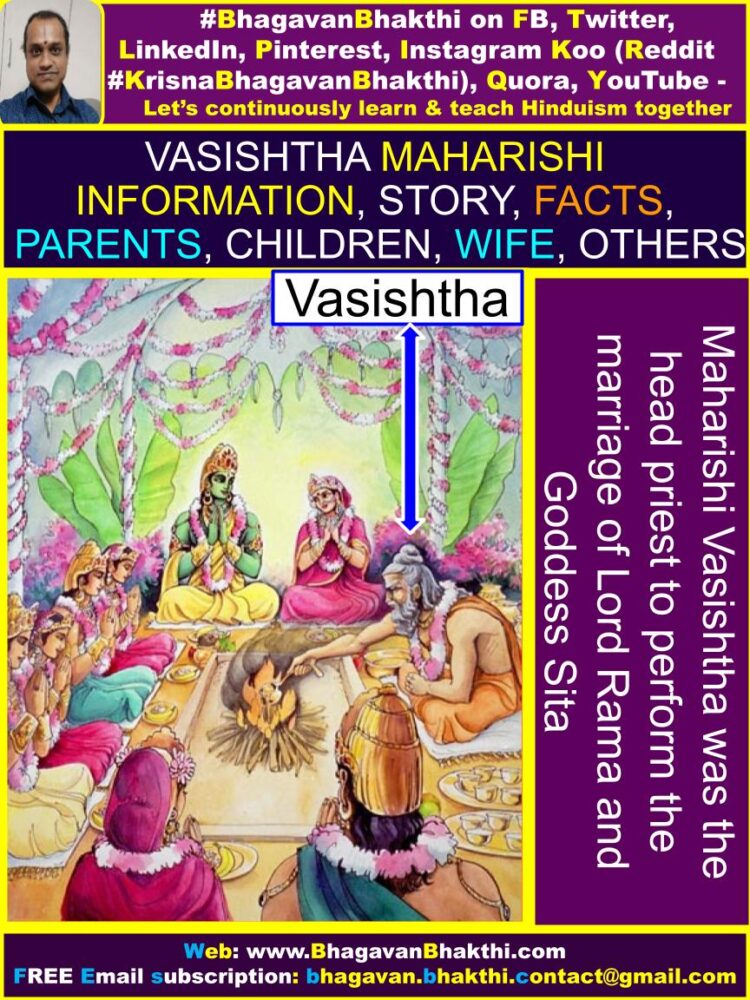
Information about Maharishi Vasishtha in Sri Vishnu Sahasranama (Purva Pithika) is as given below:
व्यासाय विष्णु रूपाय व्यासरूपाय विष्णवे ।
नमो वै ब्रह्मनिधये वासिष्ठाय नमो नमः ॥ 4 ॥
ವ್ಯಾಸಾಯ ವಿಷ್ಣು ರೂಪಾಯ ವ್ಯಾಸರೂಪಾಯ ವಿಷ್ಣವೇ ।
ನಮೋ ವೈ ಬ್ರಹ್ಮನಿಧಯೇ ವಾಸಿಷ್ಠಾಯ ನಮೋ ನಮಃ ॥ 4 ॥
vyāsāya viṣṇu rūpāya vyāsarūpāya viṣṇavē।
namō vai brahmanidhayē vāsiṣṭhāya namō namaḥ॥ 4॥
Meaning of the above shloka (hymn) : I bow down to Lord (Sage) Sri Vedavyasa, the great grandson of Maharishi Vasishtha, the grandson of that pure Rishi (Sage) Shakti and the son of Rishi (Sage) Parashara and to the father of the great penancer Sukacharya ji (Shuka Muni)!
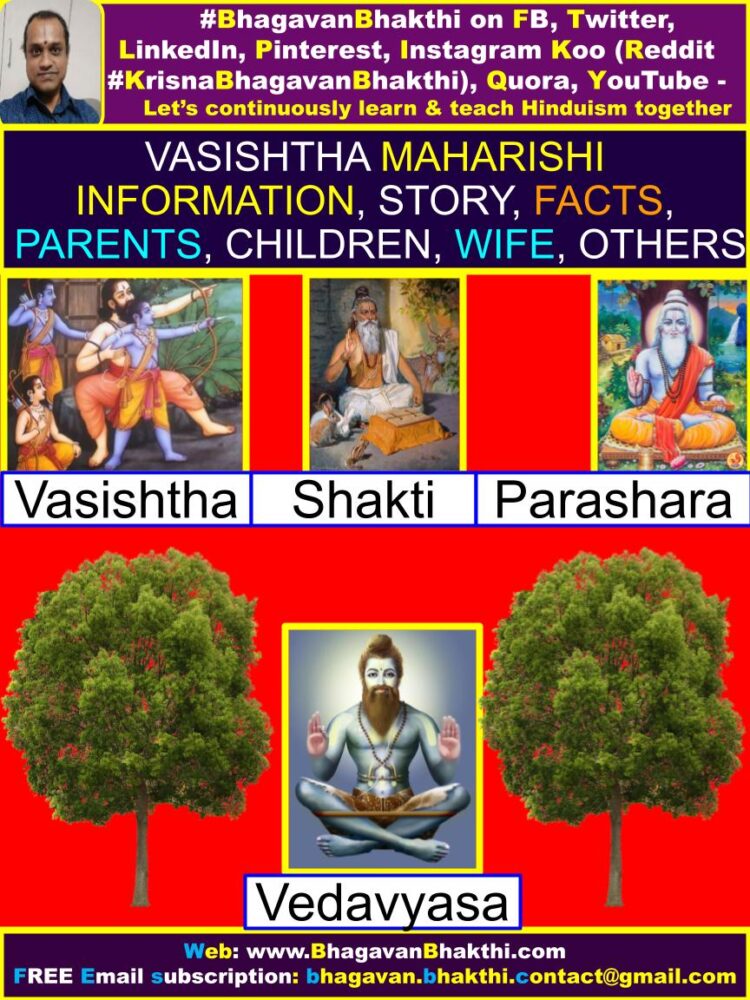
Information about Maharishi Vasishtha birth story is as given below:
[Note: Before proceeding to read this story, readers are urged to read this post completely and thoroughly to understand the real tattva / philosophy (divine truth). Reading half baked story will make us fall into Naraka (Hell). Also, remember not to be prejudicial with this story.]
Maharishi Vasishtha was also a Brahmarshi (Brahmarishi) and one of the sons of Lord Sri Brahma Deva. Maharishi Kashyapa had twin children named Mitra and Varuna from Aditi Devi (consort of Maharishi Kashyapa).
Mitra and Varuna once performed a Yajna (Sacrifice). Apart from the Devatas (Demigods), Gandharvas and Pitrus, Urvashi Devi, the most beautiful of all the Apsaras, also came to the Yajna (Sacrifice) performed by these two, that is, Mitra and Varuna.
Both Mitra and Varuna saw the most beautiful Urvashi Devi in the Yagna hall. Both Mitra and Varuna were attracted by each other. His celibacy, which he had followed with complete loyalty, was relaxed.
Mitra and Varuna’s celibacy (ब्रह्मचर्यम्), which they had followed with highest loyalty, was relaxed. They both ejaculated the sperm and they both very divinely and carefully kept the sperm in a clean Kumbha (pot).
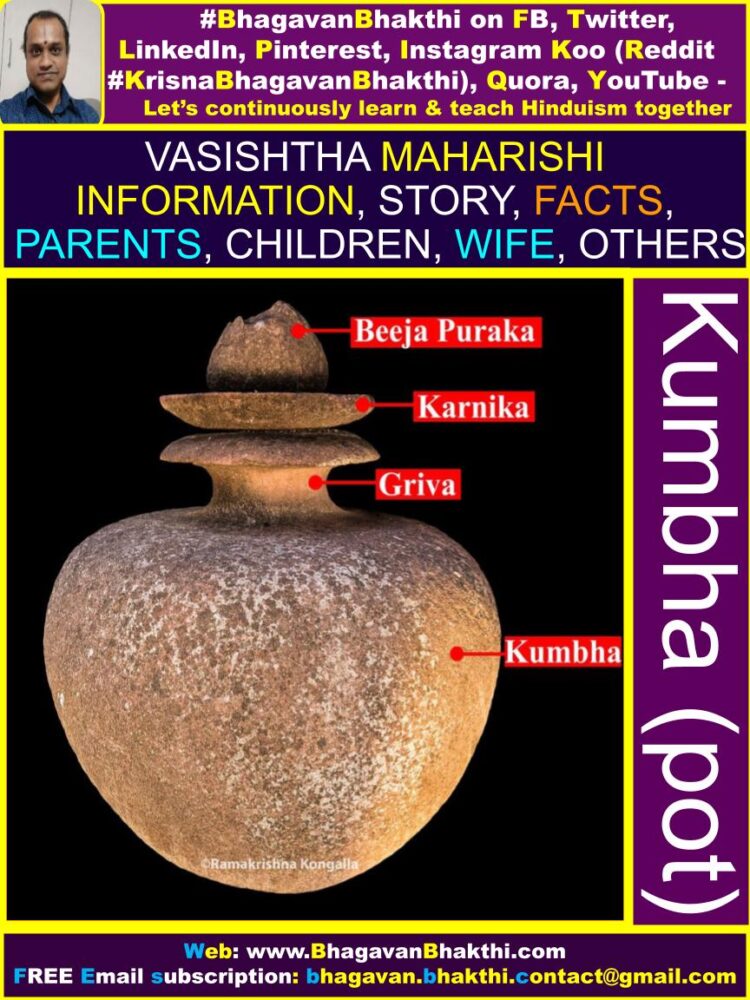
From these sperm, two children were born. The first child is Agastya. Then later, when the water in Kumbha (pot) was spilled in the lake, the second child in it floated in the lake and was sitting on a lotus flower.
Meaning of the name Vasishtha : This baby was born in an unique way and thus that baby was came to be known as Vasishtha (Born in a divinely special and unique way).
[In Sanskrit विशिष्ठ (viśiṣṭha) means divinely special and unique. Since the baby was born in this way, he is called as Vasishtha.]
Thus, Vasishtha became Varuna and Mitra’s son.
(Note : We should always remember that, these are only the pastimes / drama of Lord Sri Vishnu to teach lessons to the ordinary people. We should not at all understand this in the ordinary way. We should not think that Maharishi Vasishtha was born in illegitimate way, etc.)
(If Maharishi Vasishtha was born in the incorrect way or illegitimate way, how could he had become the great Maharishi and a Brahmarishi, and more over as one of the Saptarishi / Vedic Sage of Sanatana Dharma.)

Also remember that, in one birth Maharishi Vasishtha is born from the manasa (mind) of Lord Sri Brahma Deva. In an another avatar, Maharishi Vasishtha is again born as the son of Varuna and Mitra as explained above.
Information about Maharishi Vasishtha family background is as given below:
Maharishi Vasishtha’s consort (wife) name is Arundhati. Their son name is Shakti. Shakti’s wife name is अद्रुश्यन्ति (Adrushyanti). Their son was Parashara. Rishi (Sage) Parashara and Satyavati’s (Matsya Kanya) son is Lord (Sage) Sri Vedavyasa.
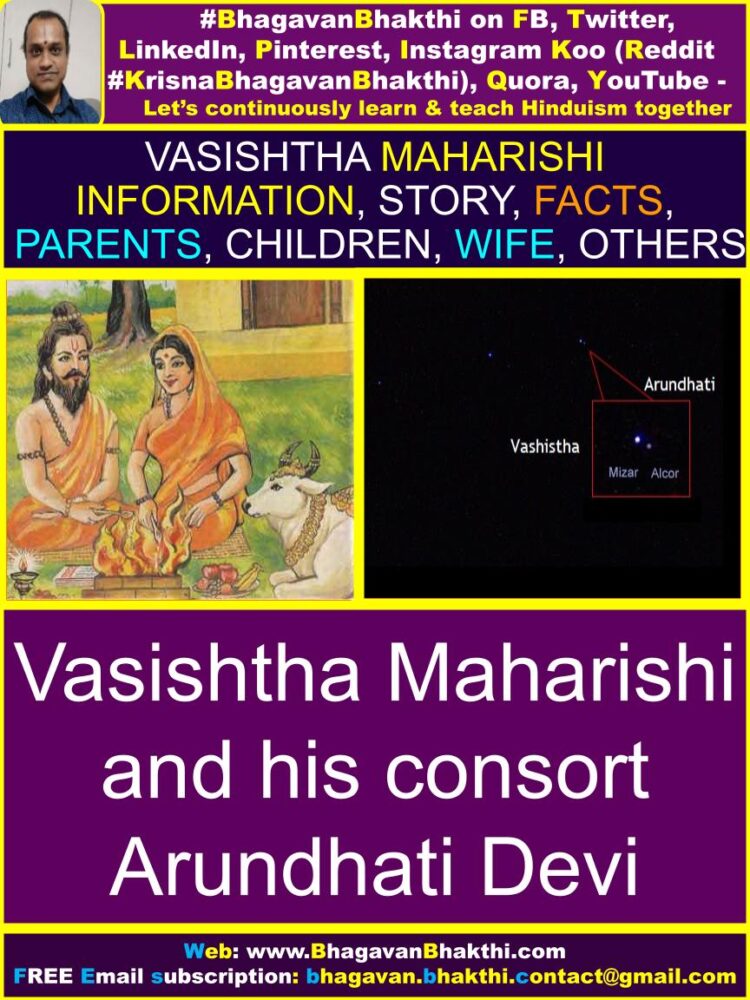
Information about Maharishi Vasishtha and Kamadhenu (Surabhi) is as given below:
Kamadhenu background : Kamadhenu (कामधेनु ), also known as Surabhi (सुरभि), is a divine bovine-goddess described in Hindu Shastras (Texts) as the mother of all the cows.
Kamadhenu or Surabhi is a divine and miraculous cow which “satisfies all the desires” and also called as “cow of plenty”, that is, who provides her owner whatever he/she desires. Also Kamadhenu or Surabhi is often depicted as the mother of other cattle as well as the eleven Rudras.
Symbolically, Kamadhenu or Surabhi is generally showcased as a whitish colored cow with a female head and breasts and also as well as a white cow containing various deities within her body. In Hinduism, all the cows are venerated as the earthly embodiment of the Kamadhenu or Surabhi.
Hindu Shastras (Texts) gives information about the diverse accounts of the birth of Kamadhenu or Surabhi. Few Texts explains that Kamadhenu or Surabhi emerged from the Samudra Manthan (Churning of the cosmic ocean).
While other texts describe Kamadhenu or Surabhi as the daughter of Daksha Prajapati, and as the consort of the Maharishi (Sage) Kashyapa. Similarly, other Texts give information that Kamadhenu or Surabhi was in the possession of either Maharishi Jamadagni or Maharishi Vasishtha.
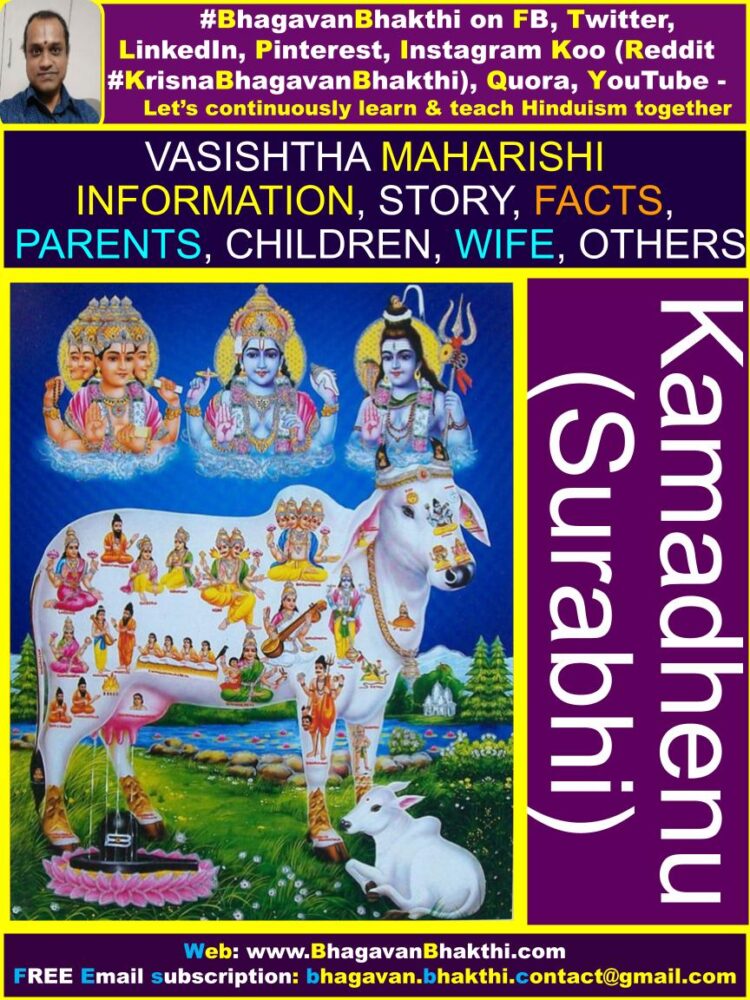
And few kings tried to steal Kamadhenu or Surabhi from the sage (Jamadagni or Vasishtha) ultimately faced dire consequences for their actions. Kamadhenu or Surabhi plays a vital role of providing milk and dairy products to be used in her master’s naivedya (oblations) as offering to Lord Sri Vishnu.
Kamadhenu or Surabhi is also capable of producing fierce warriors to protect her master from his enemies. In addition to dwelling in the master (sage) ashrama (hermitage), Kamadhenu or Surabhi is also explained as dwelling in Goloka (The realm of the cows) and Patala (The Netherland).
Information about the body parts explanation of Kamadhenu is as given below:
Kamadhenu’s four legs are the scriptural ‘Four Vedas’. Kamadhenu’s horns are the ‘Tridevas’ (Trinity) Gods Lord Sri Brahma Deva (tip), Lord Sri Vishnu (middle) and Lord Shiva (base).
Kamadhenu’s eyes are the Lord Sri Surya Deva (The Sun God) and Lord Sri Chandra Deva (The Moon Gods). Kamadhenu’s shoulders are Lord Sri Agni Deva (The Fire God) and Lord Sri Vayu Deva (The Wind God). Kamadhenu’s her legs are the Himalayas.
The birth of Kamadhenu has variety of stories among which are considered as authentic is: Kamadhenu depicted in a scene of Samudra Manthan (Churning of the cosmic ocean) by the Devatas (Demigods) and Rakshasas (Demons) to acquire Amrita (ambrosia).
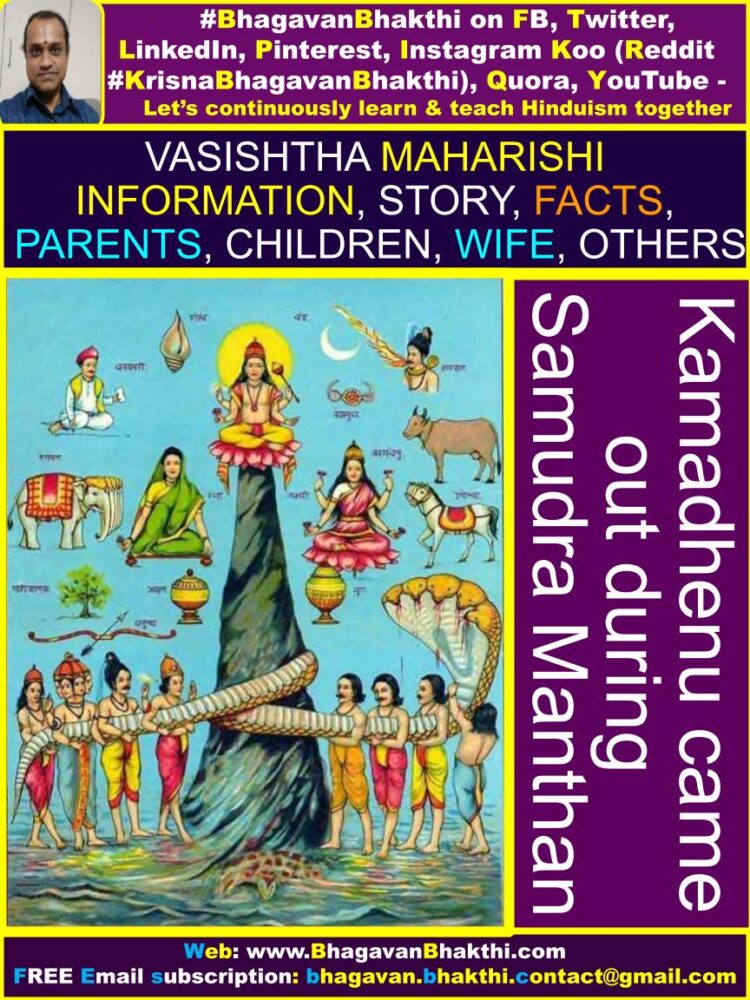
For this reason also, Kamadhenu is regarded the offspring of the Devatas (Demiods) and Rakshasas (Demons). After the Churning of the cosmic ocean, Devatas (Demigods) and Rakshasas (Demons) gave the Kamadhenu to Saptarishi (The seven Sages).
Kamadhenu was ordered by Lord Sri Brahma Deva to provide milk and it’s byproducts and supply it for various Yagnas (Sacrifices).
In Anushasana Parva of Mahabharata, it explains that Kamadhenu or Surabhi was born from the belch of Daksha Prajapati after he drank the Amrita that rose from the Samudra Manthan (Churning of the cosmic ocean).
Further, Surabhi gave birth to many golden cows called Kapila cows, who were called as the various mothers of the world.
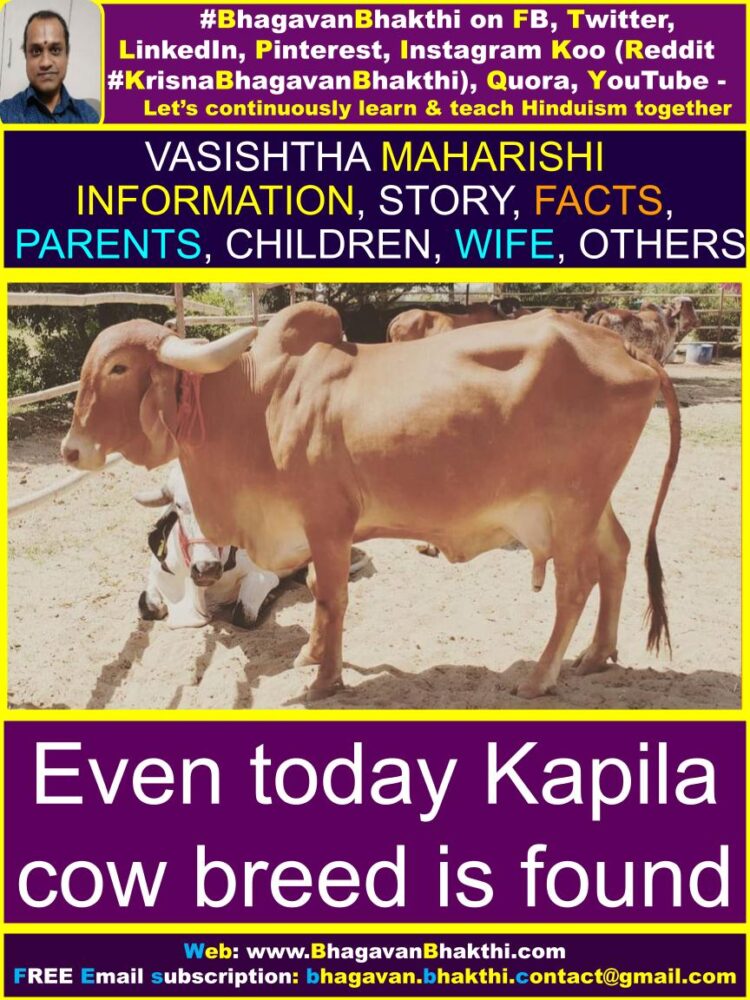
Information about Maharishi Vasishtha’s Kamadhenu (cow) is as given below (Maharishi Vasishtha and Maharishi Vishwamitra rivalry story is as given below):
The divine epic Ramayana shows a story about Kamadhenu, here the Maharishi (Sage) is Maharishi (Sage) Vasishtha and the King is Kaushika (later became Vishwamitra). Once, the King Kaushika (Vishwamitra) with his army arrived at the ashrama (hermitage) of Maharishi (Sage) Vasishtha.
Maharishi (Sage) Vasishtha welcomed King Kaushika (Vishwamitra) and offered him and his army a great hospitality along with the food which was produced by Sabala, a Kamadhenu cow.
The dumbfound King Kaushika (Vishwamitra) asked Maharishi (Sage) Vasishtha to part with Sabala and instead offered thousand of ordinary cows and other materialistic things in return.
However, Maharishi (Sage) Vashishtha refused to part with Sabala (cow), who was necessary for the performance of the sacred rituals and charity by the sage. Ruffled King Kaushika (Vishwamitra) seized the cow Sabala by force, but she returned to her master, fighting the King’s huge army.
Sabala the cow hinted Maharishi (Sage) Vasishtha to order her to destroy the King Kaushika’s (Vishwamitra) army and the sage followed her wish. Continuously Sabala (cow) produced Pahlava warriors, who were slain by King Kaushika’s (Vishwamita) army.

Thus, Sabala (cow) produced warriors of Shaka-Yavana lineage. From Sabala’s (cow) mouth emerged the Kambhojas, from her udder emerged Barvaras, from her hind emerged Yavanas and Shakas.
Similarly from Sabala’s (cow) skin, Haritas, Kiratas and other foreign warriors emerged. Together, the army of Sabala (cow) killed King Kaushika’s (Vishwamitra) army and all his sons.
This incident started the great rivalry between Maharishi (Sage) Vasishtha and King Kaushika (Vishwamitra), who renounced his kingdom and became a great Rishi (Sage) Vishwamitra to defeat Maharishi (Sage) Vasishtha by gaining similarly powers.
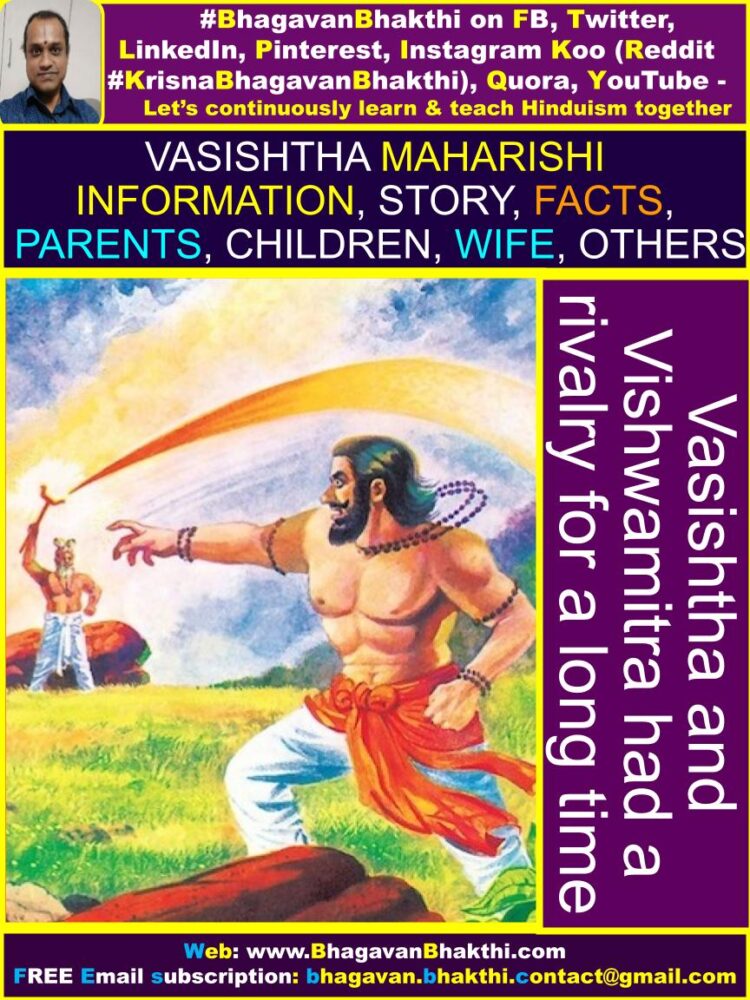
Information about abodes of Kamadhenu is as given below:
Kamadhenu (Surabhi) residence varies depending on different Hindu Shastras (Texts). The Anushasana Parva from Mahabharata tells how Kamadhenu was given the ownership of Goloka, the highly divine planet for cows located above the three worlds, that is, Svarga Loka, Earth and Netherworld.
The daughter of Daksha Prajapati, that is, Surabhi (cow) went to Mount Kailash and worshipped Lord Sri Brahma for 10,000 years. Pleased by the penance of Surabhi (cow) Lord Sri Brahma Deva conferred Goddess-hood to Surabhi (cow).
And also, adjudged that all people would worship her and her children (cows). Lord Sri Brahma Deva also gave Surabhi (cow) a world called Goloka, while her daughters would reside on earth among humans.
As said in Ramayana, Surabhi (cow) is narrated to live in the city of Lord Sri Varuna Deva (The Ocean God). This place is located below the earth in Patala (Netherworld). Surabhi’s flowing sweet milk is said to form Kshiroda or the Kshira Sagara, (The Cosmic milk ocean).
As per the Udyoga Parva from Mahabharata, this milk is said to be of six flavors and has the essence of all the divine best things of the earth.
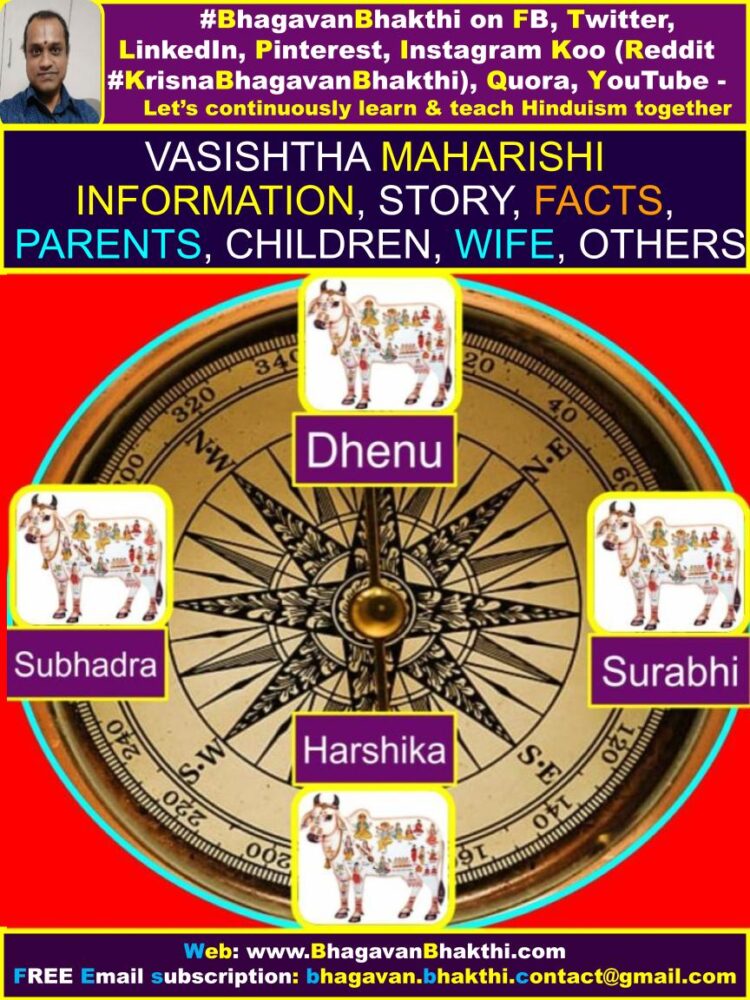
The Udyoga Parva clarifies that Surabhi (cow) inhabits the lowest realm of Patala, known as Rasatala, has for daughters, that is, for the Dikpalis, the guardian cow goddesses of Heaven. Saurabhi (cow) in the east, Harshika in the south, Subhadra in the west and Dhenu in the north.
Information about Maharishi (Sage) Vasishtha, King Dileepa (Dilip) and cow Kamadhenu & cow Nandini story is as given below:
In Sanskrit Dileepa is written as दिलीप (also pronounced as Dilipa or Dilip) was a King of the Raghuvansh (Rahuvamsha) (Solar Dynasty) lineage. King Dileepa had a wife named Sudakshina, but they had no children even after many years of marriage.
For this reason, King Dileepa visited Maharishi (Sage) Vasishtha’s ashram (hermitage), and pleaded him for his advice.
Maharishi (Sage) Vasishtha replied that, they should serve the cow Nandini (daughter of divine cow Kamadhenu), and if Nandini cow was happy with their service, she would bless them with a child.
Thus, according to Maharishi (Sage) Vasishtha advice, King Dileepa served cow Nandini every day, and attended to her every need for twenty-one days. On the twenty-first day, a lion attacks the cow Nandini.
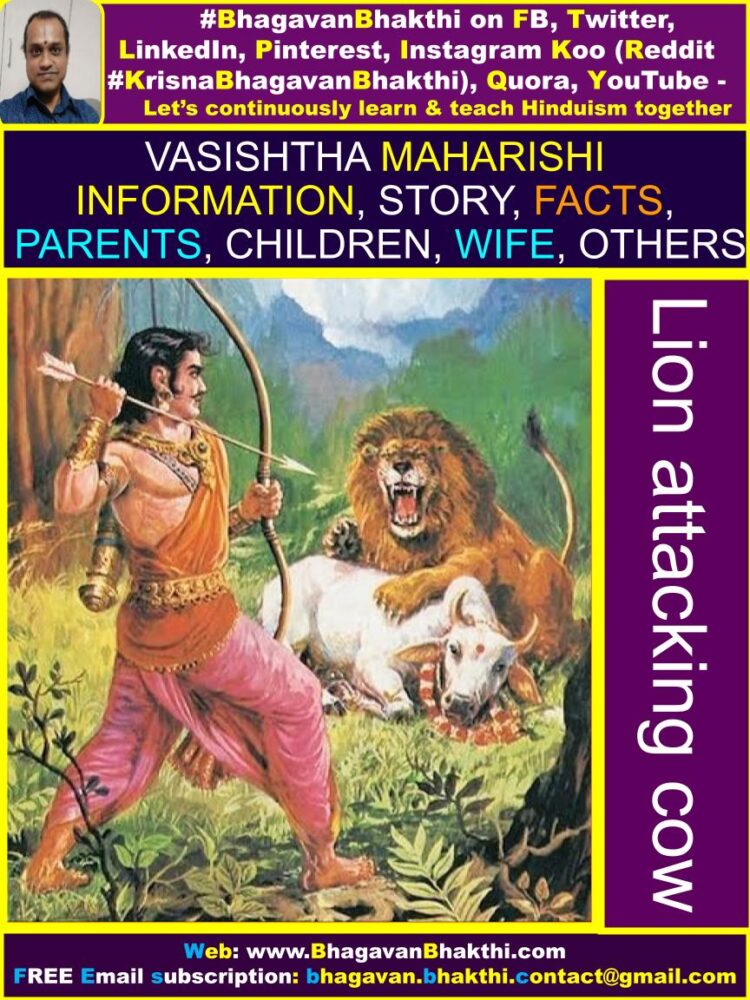
King Dileepa immediately draws his bow and tries to shoot an arrow at the lion. But King Dileepa finds that his arm is immediately paralyzed and cannot move at all. King Dileepa reasons that the lion must have some sort of divine power in it or the lion may be a Devata (Demigod).
Thus to confirm this, the lion started to speak to King Dileepa. It said that King Dileepa had no chance of saving the cow, because the cow was the lion’s chosen meal. The lion tells King Dileepa to return to Vasishtha’s ashram (hermitage) and let him (lion) have the cow Nandini as it’s food.
King Dileepa replies by asking if the lion would let cow Nandini go if he offered his own body in cow Nandini’s place. The lion agreed and King Dileepa sacrificed his life for the cow. But mysteriously, the lion disappeared from the spot.
Nandini cow explained that the lion was just an illusion to test King Dileepa devotion. Because King Dileepa was truly selfless, cow Nandini granted him a son after this devotional test.
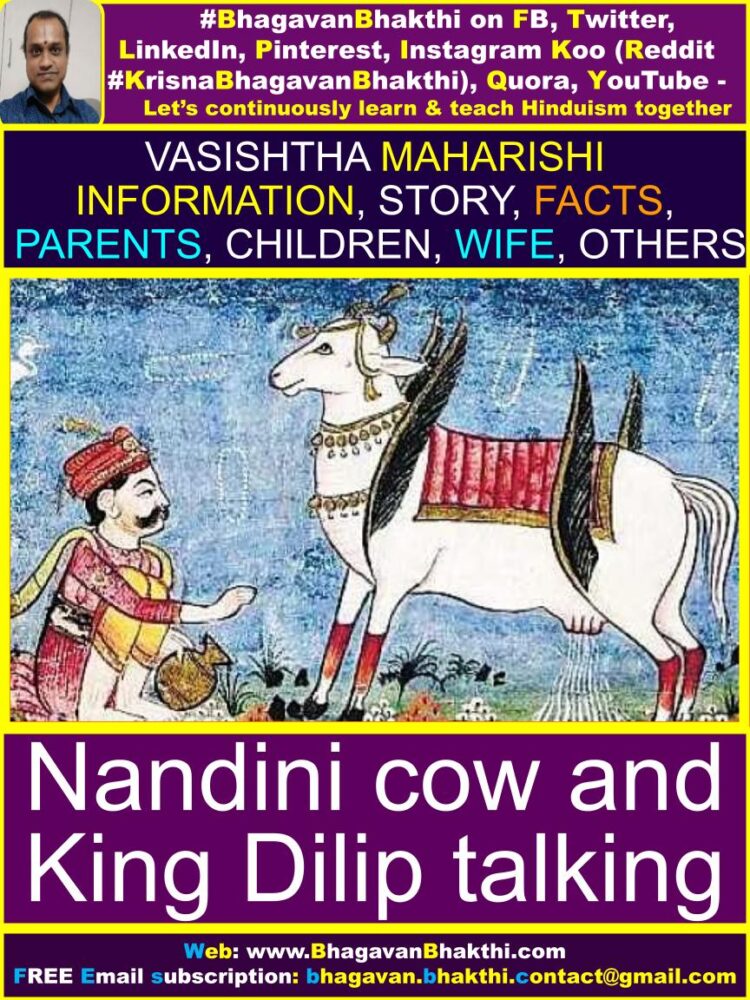
Information about Maharishi (Sage) Vasishtha’s Ashram (hermitage) is as given below:
Maharishi (Sage) Vasishtha had an Ashram (hermitage) in Ayodhya. This Ashram (hermitage) was spread over approximately 40 acres (160,000 m2) of land. In today’s situation, all that remains of this ashram (hermitage) is a compact ashram in about one fourth of an acre of land.
The ashram (hermitage) has within it a well that is believed to be the source of the river Sarayu. Maharishi (Sage) Vasishtha was the Guru of the Suryavansh (Suryavamsha) (Solar Dynasty). The King at that time was King Ikshvaku who was the King of Ayodhya.
King Ikshvaku was a noble and Dharmic King and thought of the well being of his subjects through out his life. Once, King Ikshavaku approached Maharishi (Sage) Vasishtha requesting him (Vasishtha) that the land had no water and requested him to do something to let the kingdom have adequate water.
Maharishi (Sage) Vasishtha performed a special prayer and the river Sarayu is said to have started flowing from this well from that day. River Sarayu is also known as ‘Ikshvaki’ and ‘Vasishti’. It is said that the well is connected underground with the river Sarayu.
Many spiritual people who visit this ashram (hermitage) find an enormous spiritual energy around this well. Some believe that this is one of the better spiritual tirtha (divine river) of India.

There is also another ashram (hermitage) past Rishikesh on the way to Kaudiyala on the Devprayag route and this ashram is known as ‘Vasishtha Guha Ashram’.
The ashram (hermitage) itself is located on the banks of the River Ganges and it is a very beautiful place. It has a wonderful long cave with a large dark Lord Shiva Linga installed at the end inside. There is also another cave smaller to the side facing the river called ‘Arundhati’s Cave’.
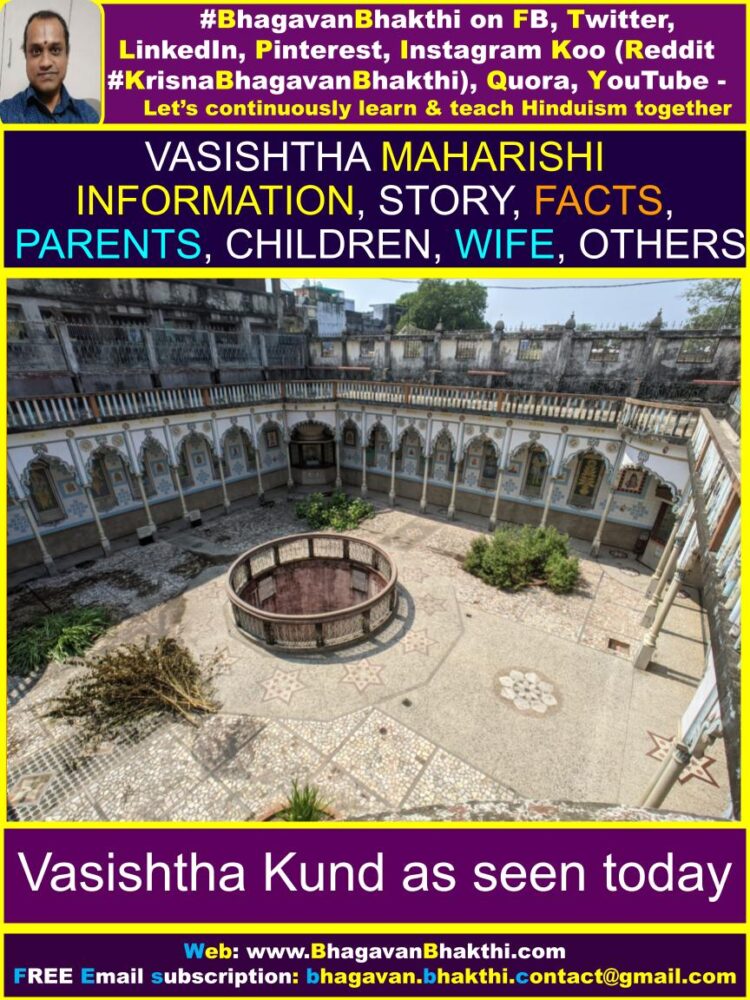
Information about Arundhati and Maharishi (Sage) Vashishtha pair of stars is as given below:
In Indian traditional astronomy, pair of ‘Alcor’ and ‘Mizar’ in constellation Ursa Major is known as Maharishi (Sage) Vashishtha and Arundhati stars respectively. Mizar is known as Maharishi (Sage) Vasishtha and Alcor is known as Arundhati in traditional Indian astronomy.
The pair of stars is considered to symbolize marriage, as Maharishi (Sage) Vasishtha and Arundhati were a married couple. In many Hindu marriage, the priest shows the Arundhati Nakshatra (star) to the new married couple.
(In some Hindu marriages, priests conducting a wedding ceremony allude to or point out the constellation as a symbol of the closeness marriage brings to a couple.)
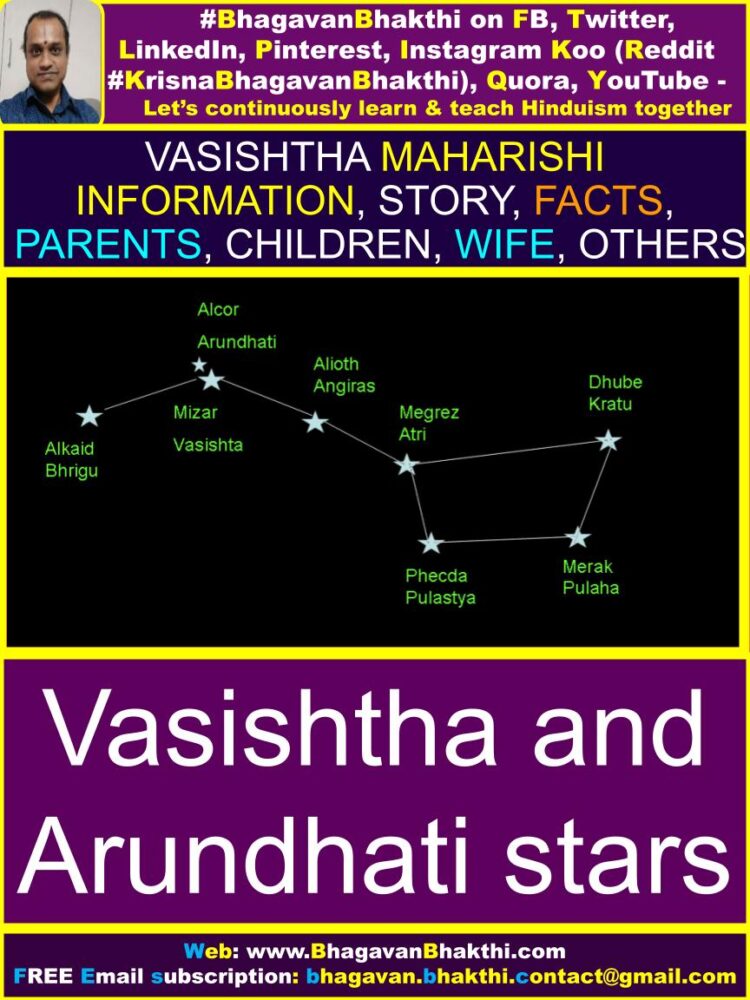
Stotram (hymn) about Maharishi (Sage) Vasishtha is as given below:
नमस्तुभ्यं वसिष्टाय जटिलाय महात्मने ।
धर्मरूपाय सत्याय लोकानां हितकारिणे ।
ನಮಸ್ತುಭ್ಯಂ ವಸಿಷ್ಟಾಯ ಜಟಿಲಾಯ ಮಹಾತ್ಮನೇ |
ಧರ್ಮರೂಪಾಯ ಸತ್ಯಾಯ ಲೋಕಾನಾಂ ಹಿತಕಾರಿಣೇ |
namastubhyaṁ vasiṣṭāya jaṭilāya mahātmanē |
dharmarūpāya satyāya lōkānāṁ hitakāriṇē |
अभ्यर्णपतिका देवी वसिष्टस्य प्रिय: सदा ।
अरुंधतीति विख्याता तां नमस्यामि सर्वदा ।
ಅಭ್ಯರ್ಣಪತಿಕಾ ದೇವೀ ವಸಿಷ್ಟಸ್ಯ ಪ್ರಿಯ: ಸದಾ |
ಅರುಂಧತೀತಿ ವಿಖ್ಯಾತಾ ತಾಂ ನಮಸ್ಯಾಮಿ ಸರ್ವದಾ |
abhyarṇapatikā dēvī vasiṣṭasya priya: sadā |
arundhatīti vikhyātā tāṁ namasyāmi sarvadā |
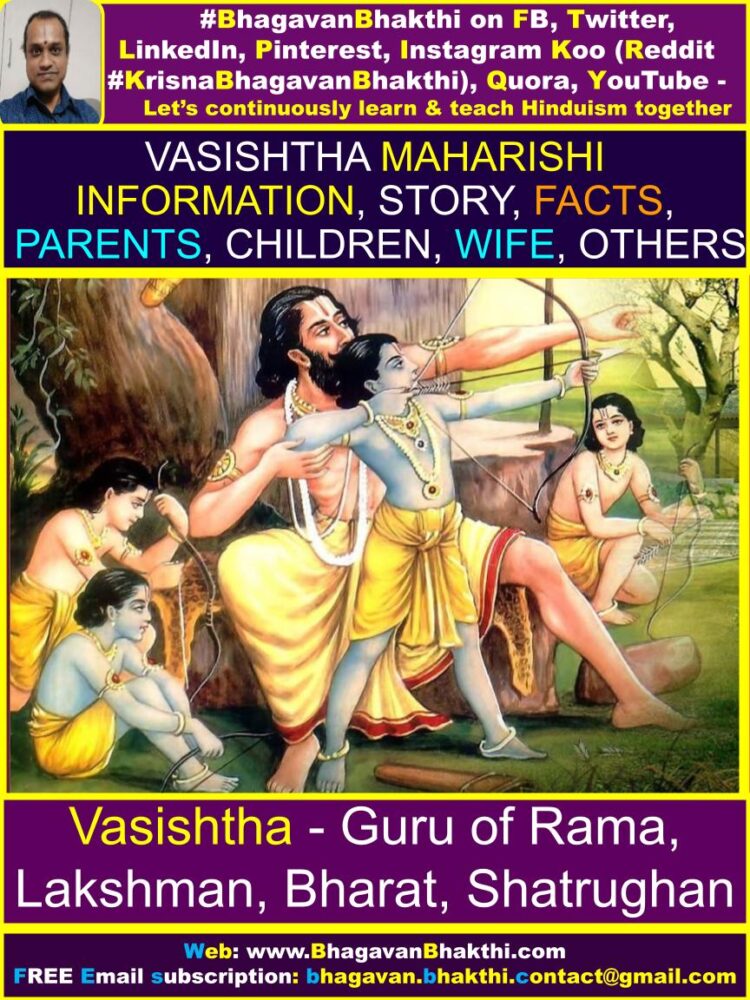
More information will be added to his post (article) on regular basis. Please visit again to know the updated information after some time.
To watch videos on #Hinduism #Sanskrit language, SUBSCRIBE to my YouTube channel from this below link:
#BhagavanBhakthi YouTube channel
To know more about “Different Maharishi (Rishi) information, facts, details“, please click the below link:
Different Maharishi (Rishi) information, facts, details
Dear friends, if you need any clarifications about this post, kindly let me know, I will definitely try to answer all of them.
Also your one LIKE, one COMMENT, One Share, one SUBSCRIPTION is highly important.
This will help to know the quality of this content and also it will be helpful to know if any improvements is required for the content.
If you feel this content is useful to you and has helped you to improve your knowledge, kindly share this with your well-wishers.
Because “SHARING MEANS CARING”.
To receive FREE EMAIL SUBSCRIPTION about #BhagavanBhakthi, you can send an email to bhagavan.bhakthi.contact@gmail.com from your email ID.
NAMASTE!
Sri Gurubhyo Namaha
Sri Krishnaayan Namaha
Sri Krishnaarpanamastu
Satisfying. I want to know that, are the kamboja dynasty (Mahabharat time king – Kamatha) from those kamboja ksatriya’s blood leneage you mentioned who emerged from Kamdhenu mata’s mukh-dvara? I want to know because my study says I’m also from Kambojas